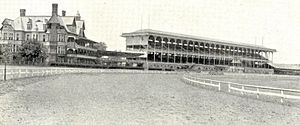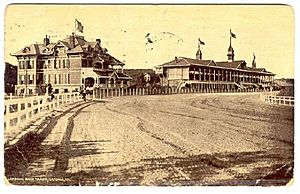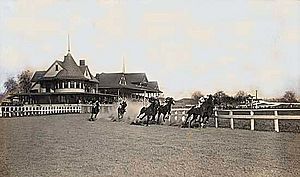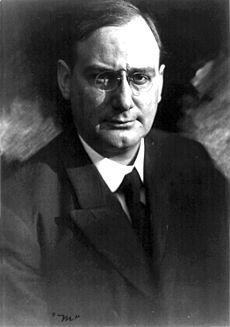Andrew Tilles facts for kids
Quick facts for kids
Cap Tilles
|
|
|---|---|

C. A. Tilles in St. Louis, MO
|
|
| Born | November 25, 1865 |
| Died | November 22, 1951 (aged 85) St. Louis, Missouri
|
| Education |
|
| Occupation |
|
| Parent(s) | Louis Tilles (February 13, 1829 – September 11, 1875) Rosalie Peck Tilles(1837-10 Aug 1872) |
| Relatives |
|
Andrew "Cap" Tilles (born November 25, 1865 – died November 22, 1951) was an American businessman and someone who gave a lot of money to good causes (a philanthropist). From a young age, he was known by his nickname, Cap. He made big changes to the horse racing industry in the United States.
Later in his life, Cap Tilles used his wealth to help people in St. Louis, Missouri. In 1896, he helped start an investment group that became very powerful in horse racing. This group was known as the "Big Three" and was officially called C.A.T., short for Cella, Adler, and Tilles.
Contents
The Early Life of Cap Tilles
Cap Tilles was born in St. Louis, Missouri. His parents were Louis and Rosalie Tilles. He had several brothers and sisters, including George Tilles, Sr. When Cap was young, his family moved to Fort Smith, Arkansas. There, his father started a tobacco and cigar company.
Sadly, both of Cap's parents passed away when he was still a child. This left him and his siblings without parents. Cap was later adopted by Mrs. Josephine Adler, who was the mother of his future business partner, Sam Adler. Cap went to the University of Arkansas for a short time. In 1882, he returned to Fort Smith to work with his older brother George in the family's cigar factory.
Starting a Business in St. Louis
In 1886, Cap Tilles and his friend Sam Adler moved to St. Louis, Missouri. They wanted to start their own tobacco and cigar business. They bought a cigar store, which did very well. This success helped them earn enough money to begin investing in other ventures.
Cap Tilles and Horse Racing
Cap Tilles and Sam Adler soon bought a closed horse racing track in St. Louis in 1892. They first thought about turning it into a baseball park. Instead, they decided to reopen it as a race track. To make it special and avoid competition, they installed electric lights. This made their South Side Track the first place to ever hold night horse races!
The C.A.T. Partnership Grows
The night races were a huge success. This allowed Tilles and Adler to buy another track, the Madison Track. They did this with the help of a wealthy man named Louis A. Cella. In the mid-1890s, Cella joined Tilles and Adler to form the Western Turf Association, also known as C.A.T. (Cella, Adler, and Tilles).
The C.A.T. partnership quickly grew. They bought the Delmar Investment Company and the Delmar Racing Track in St. Louis. They spent a lot of money to make Delmar a very modern racing facility. By 1902, Cap Tilles had gained control of almost all horse racing in the St. Louis area. He wanted fair rules where any jockey or horse could race.
Expanding Across the Country
By 1911, the C.A.T. partnership owned tracks in many other states. These included cities like Memphis, Little Rock, New Orleans, Detroit, and Buffalo. Cap Tilles even tried to buy Churchill Downs, a very famous track. By 1914, Tilles owned 25 horse racing tracks across the United States. This was more than any other investor in U.S. history.
Tilles changed horse racing by bringing in electricity for night races. He also helped create the modern way of licensing people who took bets (bookmakers).
Challenges from New Laws
Around 1900, horse racing was very popular. But some people, called "progressives," thought gambling was bad. They wanted to stop it. In Missouri, Governor Joseph W. Folk (elected in 1904) tried to ban horse racing and gambling.
In 1905, a new law was passed that made it illegal to take bets at horse races in Missouri. This was a big problem for Tilles and his partners, as betting was their main source of income. The Delmar Track continued to operate for a short time, but eventually, the police shut it down.
Because of these new laws, Tilles' partnership lost four tracks in St. Louis. This forced them to expand their business even more into other states where gambling was still allowed.
Cap Tilles: A Philanthropist
Later in his life, Cap Tilles focused on giving back to the community. He used his wealth to help others.
Louis Tilles Park
In 1924, Cap Tilles created the Louis Tilles Children's Park in Fort Smith, Arkansas. He named it after his late father. The park was 12 acres and included a statue honoring a soldier from World War I. This park is still open today.
The Tilles Foundation
In 1926, Cap Tilles started a charitable organization called the Rosalie Tilles Non-Sectarian Charity Fund. He gave a million dollars to this fund as a Christmas gift for the poor children of St. Louis. He named it after his mother, Rosalie Peck Tilles.
The Tilles Foundation still exists today. Its main goal is to help children in St. Louis who need financial help for their education or health. Since 1955, it also provides scholarships for university students.
Rosalie Tilles Park
In 1932, Tilles donated a large piece of land (68 acres) in St. Louis County to the City of St. Louis. This park was also named after his mother, Rosalie Peck Tilles. It was developed with government funds and is still a beloved park today.
Family Life
The Tilles family name comes from a Hebrew word meaning "praise" or "noble light." Cap Tilles' family came from an area that is now part of Poland.
Cap Tilles married Cora Lee Eddington in 1901. They traveled a lot, but they later divorced. Cap Tilles never married again and did not have any children. However, he stayed close with his siblings and worked with them on many of his charitable projects.
His Legacy
Cap Tilles had a long and sometimes debated career in business. He was known for his work in horse racing and investments. Some people admired him for building modern race tracks and finding ways to keep racing going. Others thought his business practices were too powerful or that gambling was wrong.
Cap Tilles wanted to be remembered as a successful businessman. He started with humble beginnings and became very wealthy, even after being orphaned as a boy. In his later years, he hoped that his charity work would help other children who were struggling, just like he had.






